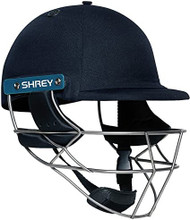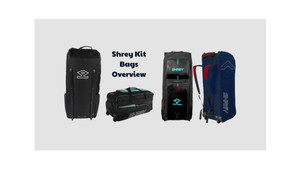Evolution of Cricket Helmets and Its Safety: How Shrey Helmet does it
Posted by Cricket Store Online on 20th Oct 2020
Even though cricket playing started in the 18th century, cricketers didn’t begin the use of cricket helmets till the mid 19th century. The first person to wear it was an England cricketer known as Patsy Hendren, who wore a helmet in a competition against the West Indies. Its use became prevalent in the 1970s when other players like Dennis Amiss, Graham Yallop, Tony Greig, and Sunil Gavaskar all wore different orthodox designs of the cricket helmet.
There’s a popular cricket joke which goes thus, “It took hundred years for men to realize the brain is also important.” Definitely written by a woman! The use of cricket helmets was started by batters to protect their heads from hits by the ball. However, close in-fielders and wicket keepers now wear it as they also risk being hit by the ball.
There were different designs of the cricket helmet back in the day. From Sunil Gavaskar’s Skull Cap to Tony Greig’s motorcycle helmet-like cricket helmets, players have come up with different contraptions to protect themselves. With cutting-edge technology now being used in producing cricket gear, cricket helmets have been designed in such a way to minimize or even eliminate the probability of injuries.
Different parts of a cricket helmet
o The Shell
This is the dome and the most essential component of the cricket helmet. The outer shell of the cricket helmet provides a large surface area, which helps to reduce the brunt of the impact.
It has different raw materials, such as carbon steel, fiberglass, and ABS plastic. The inner part helps to soak up the shock that hits the outer part. This way, the cricketer doesn’t feel any discomfort.
o The Grill
This is the net-like part attached to the shell and also an important part of the cricket helmet. It helps to protect the face from injury and is made from materials like polycarbonate and titanium. The grill should have a design such that it doesn’t impede visibility and ventilation too much and guarantees maximum protection. The ones made from steel tend to make the helmet quite heavy, but with materials like titanium, safety, as well as a featherweight helmet, it is a sure guarantee.
Some cricketers choose not to attach grills to their helmet. Although this increases visibility, it also reduces protection.
o The Padding
It is a soft material attached to the inner part of the cricket helmet. It helps to absorb shock and makes the helmet grip the head of the cricketer better. It can be adjusted to fit different head sizes.
o Chin Strap
The chin strap is attached to the shell of the material and is used to attach the cricket helmet to the head firmly. Another use is to protect the chin.
o Neck Guard
This is a cricket helmet component that was added recently after the unfortunate death of Australian cricketer Phillip Hughes after he was hit in the neck by a cricket ball. The neck guard is an accessory attached to the back of the cricket helmet to prevent such occurrences from happening again.
Different materials used in making cricket helmets
o Carbon Steel
This material is known for its strength and is the right choice of helmet if you need efficient protection. It is, however, heavy and might cause discomfort when being used for an extended period. It meets every parameter of international cricket standard.
o ABS Plastic
This is one of the lightest materials used in making cricket helmets. However, it is relatively light on its protective qualities. It is most suitable for junior players who are more likely not to get exposed to high speeds of bowling.
o Carbon Fiber
Carbon fiber is used in combination with Kevlar to make a more robust and lighter helmet. The helmet is known for its impact-proof prowess. However, it is more expensive than other helmets due to the premium quality of the materials used in making carbon fiber cricket helmets.
o Titanium
Titanium is one of the lightest and most robust materials used in making helmet grills. It combines the strength of carbon fiber with the weight of ABS plastic. Due to its lightweight, it can be worn comfortably for long periods. Shrey helmets have been known to incorporate this into most of their helmets.
o High-Density Foam
The padding of cricket helmets makes use of high-density foam. It is made from polyethylene and gives the wearer more comfort.
Different sizes of cricket helmets
Different sizes of cricket helmets are available for different ages. It is imperative you know the size range for your age before buying a helmet. You should also check the manufacturer’s size tag for the helmet before making purchases. Below are the size ranges for different age groups:
Small boys will wear sizes in the range of fifty-one to fifty-four centimeters while adolescents will use fifty-four to fifty-eight centimeters of helmet sizes. The ranges for adults are from fifty-eight to sixty-two centimeters.
How Shrey Helmet does it?
In late 2012, a young member of the Kohli family (who owned the TK Sports) by the name of Shrey was on his way to deliver some kits to the players of the Uttar Pradesh team. However, he never made it there as he died in a car crash ending his tender life at the age of 21.
The family started the Shrey Cricket Betting helmets line to immortalize his name, and the rest they say is history. Shrey helmets are used by 60% of the players of the Indian premier league, and the sporting outfit has exclusive rights to the sporting apparel for some IPL teams. How have they been able to achieve this in less than a decade since the start of the cricket helmets line?
First, they are known for their cutting-edge technology, which they use in making their helmets. Most of their helmets are made from titanium and stainless steel. This is the secret for their lightweight helmets.
Another change the Shrey line made to their helmets (especially the wicket-keeping helmets) is the shortening of the helmet peak. This helps the wicket-keeper get unhindered vision while staying fully protected from any balls in the air.
The Shrey helmet is a class apart from the rest in their neck guards. They do not only protect your neck but a Shrey neck guard is compatible with all types of helmets. This means you could get a Shrey neck guard and use it with a Shrey Air or a Shrey Match helmet. The versatility of their neck guards is also another thoughtful addition that lenders them to their users.
Lastly, there’s also the scholar neckline added to the wicket keepers helmets. Most wicket keepers stay on the pitch for a long time and if the helmet is too tight, it becomes uncomfortable. However, with the Shrey scholar neckline, the helmet is well cushioned and gives the user optimum comfort and convenience.
All these features and more provide the world-class quality that is synonymous with Shrey helmets.
They have a range of helmet products like their AIR Titanium helmets, Match helmets, and the Junior Cricket Helmet, which meet international cricket standards. All these products are renowned for their ultra-lightweight and protective ability.
If you’re looking to purchase a helmet that will give you optimum comfort and still provide the maximum protection needed, then Shrey helmets are the right choice for you. Good luck on the field!






